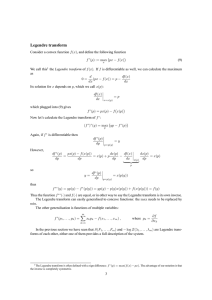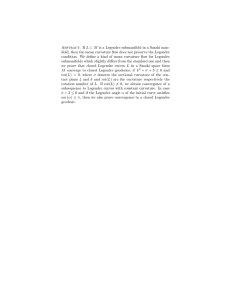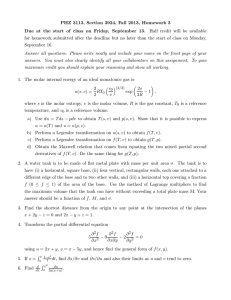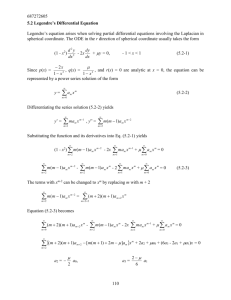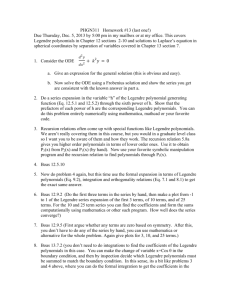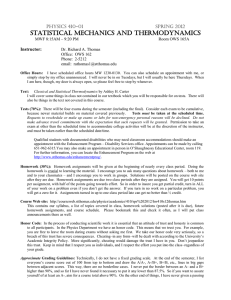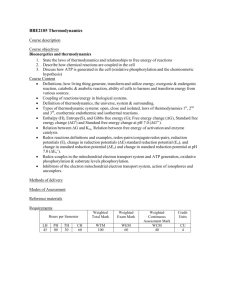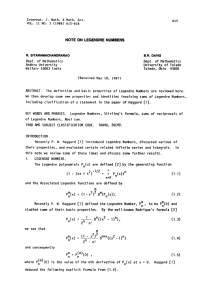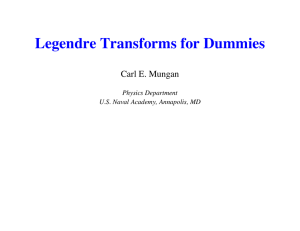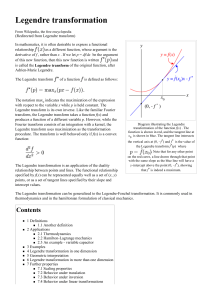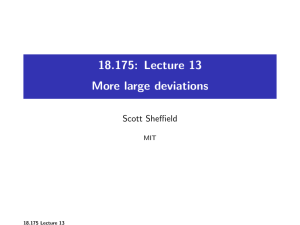Legendre transform in two-dimensional thermodynamics Haynes Miller Fall, 2008
advertisement
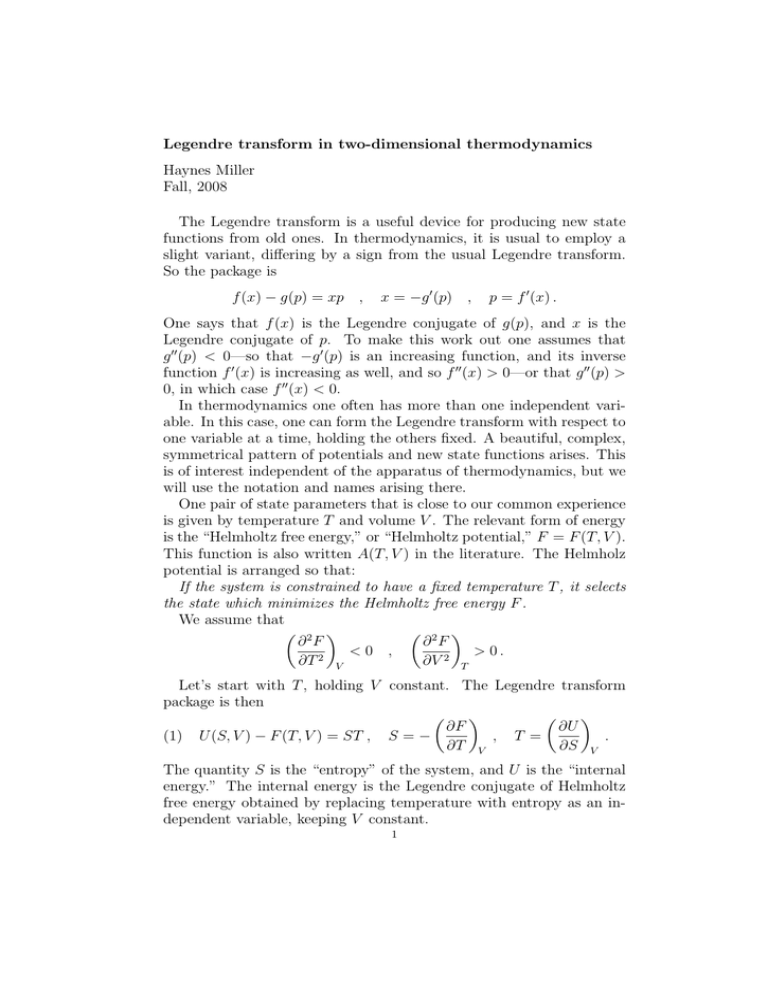
Legendre transform in two-dimensional thermodynamics Haynes Miller Fall, 2008 The Legendre transform is a useful device for producing new state functions from old ones. In thermodynamics, it is usual to employ a slight variant, differing by a sign from the usual Legendre transform. So the package is f (x) − g(p) = xp , x = −g 0 (p) , p = f 0 (x) . One says that f (x) is the Legendre conjugate of g(p), and x is the Legendre conjugate of p. To make this work out one assumes that g 00 (p) < 0—so that −g 0 (p) is an increasing function, and its inverse function f 0 (x) is increasing as well, and so f 00 (x) > 0—or that g 00 (p) > 0, in which case f 00 (x) < 0. In thermodynamics one often has more than one independent variable. In this case, one can form the Legendre transform with respect to one variable at a time, holding the others fixed. A beautiful, complex, symmetrical pattern of potentials and new state functions arises. This is of interest independent of the apparatus of thermodynamics, but we will use the notation and names arising there. One pair of state parameters that is close to our common experience is given by temperature T and volume V . The relevant form of energy is the “Helmholtz free energy,” or “Helmholtz potential,” F = F (T, V ). This function is also written A(T, V ) in the literature. The Helmholz potential is arranged so that: If the system is constrained to have a fixed temperature T , it selects the state which minimizes the Helmholtz free energy F . We assume that 2 2 ∂ F ∂ F <0 , > 0. 2 ∂T V ∂V 2 T Let’s start with T , holding V constant. The Legendre transform package is then ∂F ∂U , T = . (1) U (S, V ) − F (T, V ) = ST , S = − ∂T V ∂S V The quantity S is the “entropy” of the system, and U is the “internal energy.” The internal energy is the Legendre conjugate of Helmholtz free energy obtained by replacing temperature with entropy as an independent variable, keeping V constant. 1 2 We claim that (2) ∂F ∂V = T ∂U ∂V . S This follows from the Legendre relation: differentiate with respect to V , holding both S and T fixed. Therefore, the condition of minimizing F for fixed T is equivalent to the condition of minimizing U for fixed S, so: If a system is constrained to have fixed entropy S, it selects the state which minimizes the internal energy U . We find that 2 2 ∂ U ∂ U >0 , > 0. 2 ∂S V ∂V 2 S We can also swap V for a new variable, P , keeping T constant: ∂G ∂F , V = . (3) G(T, P ) − F (T, V ) = P V , P = − ∂V T ∂P T P is “pressure,” and G is the “Gibbs free energy” or “Gibbs potential.” Differentiating (3) with respect to T , holding both V and T constant, gives us ∂F ∂G (4) = . ∂T V ∂T P We find that ∂ 2G ∂T 2 <0 , P ∂ 2G ∂P 2 < 0. T Then we can, if we want, take U and swap V for a new variable, keeping S constant: ∂U ∂H (5) H(S, P ) − U (S, V ) = P V , P = − , V = . ∂V S ∂P S The identity (2) implies that P = P . This new potential H(S, P ) is the “enthalpy” of the system. We get a third claim, as well: ∂U ∂H (6) = . ∂S V ∂S P We find that ∂ 2H ∂S 2 >0 , P ∂ 2H ∂P 2 < 0. S 3 A system subject to fixed pressure P selects the state which minimizes enthalpy H. This is the same state as that which minimizes the internal energy U for fixed volume V . Or we could take G and swap T for a new variable, keeping P constant: (7) ∂G ∂H H(S, P ) − G(T, P ) = ST , S = − , T = . ∂T P ∂S P The identity (4) implies that S = S. Then H = ST + G = ST + P V + F = P V + U = H Combining the formulas for T in (1) and (7) confirms (6). Differentiating (7) with respect to P gives the identity ∂G ∂H (8) = ∂P T ∂P S which we already know by combining the formulas for V in (3) and (5). Summary: Application of the Legendre transform takes a parametrization of the state space by two variables and a potential function of those two variables, and produces two other parameters and three other potentials. The result is that each of the parameters has two expressions as a partial derivative of a potential. The relationships between the four potentials and the four state parameters can be summarized by the following formulas for the total differentials of the various potentials: dU = T dS − P dV dF = −S dT − P dV dG = −S dT + V dP dH = T dS + V dP together with the relations U (S, V ) − F (T, V ) = ST = H(S, P ) − G(T, P ) G(T, P ) − F (T, V ) = P V = H(S, P ) − U (S, V ) . Maxwell’s relations: Using (1), commutativity of partial derivatives, and (3), ∂S ∂ ∂F ∂ ∂F ∂P = = = . − − ∂V ∂V ∂T ∂T ∂V ∂T T T V V T V 4 Similarly, using other pairs of odd other equations in: ∂S ∂P = ∂V T ∂T V ∂V ∂S =− ∂T P ∂P T These merely express the fact that are closed. numbered equations gives us the ∂T ∂P =− ∂V S ∂S V ∂V ∂T = . ∂S P ∂P S the differentials of the potentials Gibbs-Helmholtz equations: Calculate ∂(F T −1 ) ∂F = T −1 − F T −2 = ST −1 − F T −2 = −U T −2 ∂T ∂T V V so that (9) U = −T 2 ∂(F/T ) ∂T . V Exactly similar calculations lead to seven other identities: ∂(F/T ) ∂(U/S) 2 2 U = −T F = −S ∂T ∂S V V ∂(G/P ) ∂(F/V ) F = −P 2 G = −V 2 ∂V ∂P T T ∂(G/T ) ∂(H/S) H = −T 2 G = −S 2 ∂T ∂S P P ∂(U/V ) ∂(H/P ) H = −V 2 U = −P 2 . ∂V ∂P S S Quadratic thermodynamics: With F (T, V ) = − T2 V 2 + 2 2 we find S2 V 2 + 2 2 2 T P2 P = −V , G(T, P ) = − − 2 2 S2 P 2 H(S, P ) = − 2 2 The “ideal gas law”: A “fundamental relation” is an explicit formula for one of the potentials in terms of its natural variables. S=T , U (S, V ) = 5 Usually one gives much less information than that. For example, the “ideal gas law” (Clapeyron, 1834) is the relation P V = RT where R is constant. A relation among system parameters, such as this, is an “equation of state.” This implies that ∂P R = . ∂T V V From dU = T dS − P dV we find, using one of Maxwell’s relations, ∂U ∂S ∂P (10) =T −P =T −P ∂V T ∂V T ∂T V so in an ideal gas ∂U ∂V =T T R − P = P − P = 0. V This relation is known as “Joule’s law,” and (10) shows that it is equivalent to the relation ∂P P = . ∂T V T Under the hypothesis only of Joule’s law, P = T f 0 (V ) for some function f (V ). Now 0 T f (V ) = P = − ∂F ∂V T integrates to F (T, V ) = g(T ) − T f (V ) for some function g(T ). Then ∂F S=− = f (V ) − g 0 (T ) ∂T V and U depends only on T : (11) U (S, V ) = ST + F (T, V ) = g(T ) − T g 0 (T ) . Conversely, it is clear that if U depends only on T , then so Joule’s law is equivalent to U depending only on T . ∂U ∂V = 0, T 6 Another relevant condition is the assumption that the “heat capacity at constant volume,” ∂U cV = ∂T V is constant. The conjunction of this condition with Joule’s law is equivalent to requiring U = a + cV T They give g(T ) = a+bT −cV T ln T for some a, b. We take this moment to normalize the potentials, by choosing U so that a = 0. Then ∂U ∂F F (T, V ) = (cV − S)T , T = , S=− . ∂S V ∂T V ∂cV T We can solve T = to get ∂S V T = e(S/cV )−k(V ) for some function k(V ). (We’ve taken the liberty of forcing T > 0.) We now have a pretty explicit fundamental relation, depending on the function k(V ): U (S, V ) = cV e(S/cV )−k(V ) . Also, S = cV (ln T + k(V )) so F (T, V ) = cV T (1 − ln T − k(V )) and incidentally we have computed the two functions of interest earlier: g(T ) = cV T (1 − ln T ) , f (V ) = cV k(V ) . So P = T f 0 (V ) = cV T k 0 (V ) . If the ideal gas law holds and cV is constant, then this equation implies R 1 = k 0 (V ) cV V so k(V ) = c−1 V (S0 + R ln V ) for a constant S0 . Then T = V −R/cV e(S−S0 )/cV , S − S0 = cV ln T + R ln V and we get explicit fundamental relations: U (S, V ) = cV V −R/cV e(S−S0 )/cV 7 F (T, V ) = cV T (1 − ln T ) − T (S0 + R ln V ) depending upon the parameters R, cV , and S0 . As long as V and cV are positive, the condition 2 ∂ U >0 ∂S 2 V holds. If R is also positive then also 2 ∂ U > 0. ∂V 2 S The “ideal van der Waals fluid”: The van der Waals ansatz (1873) modifies the ideal gas law, and its companion assumption that cV is constant, to accomodate interaction between particles in the fluid. Reference: Herbert B. Callen, Thermodynamics and an Introduction to Thermostatistics. The ideal gas law gets replaced by the equation of state RT a P = − 2 V − V0 V and the hypothesis that U = cV T with cV constant gets replaced by a U = cRT − . V We can integrate ∂F RT a = −P = − + 2 ∂V T V − V0 V to a F (T, V ) = −RT ln(V − V0 ) − + f (T ) V for some function f (T ). Then ∂F S=− = R ln(V − V0 ) − f 0 (T ) ∂T V so a a F = U − ST = cRT − − ST = cRT − − RT ln(V − V0 ) + T f 0 (T ) . V V Comparing these two expressions for F gives a differential equation for f (T ): T f 0 (T ) = f (T ) − cRT . The solution is f (T ) = kT − cRT ln T for a constant k. Thus a F (T, V ) = −RT ln(V − V0 ) − − cRT ln T + kT V 8 and S − S0 = R ln(V − V0 ) + cR ln T where we write S0 = cR − k. Solving for T : e(S−S0 )/cR . (V − V0 )1/c Plugging this into the hypothesized form for U gives the fundamental relation e(S−S0 )/cR a U (S, V ) = cR − . 1/c (V − V0 ) V T =
